Embroidered Flora & Fauna: Three-Dimensional Textured Embroidery is … well, quite a book! I hesitated about buying it, really, because I thought “No – it’s just not me.” But I was won over by a fig…
The title of this embroidery (more “fiber art”) book is daunting, and the double authors with double names is, too: Embroidered Flora & Fauna: Three-Dimensional Textured Embroidery, by Lesley Turpin-Delport & Nikki Delport-Wepener. Wow. It’s a mouthful. I’m funny about titles. I often tend to judge books by titles, and, though I try not to, I tend to judge books by their covers, too!
It was the cover that enticed me to buy this book after all, even though I was skeptical about it at first.
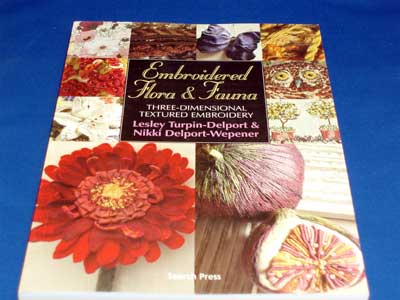
The red flower in the lower left is an eye-grabber, isn’t it? But that isn’t what grabbed me! It was the fig right next to the flower. Now, that is a fig, if I’ve ever seen one. A fig. And it’s embroidered. Wouldn’t it be fun to have a bowl of embroidered figs in the middle of your table?
If an embroidered fig could look so like a fig, I thought the book had to be worthwhile.
And I was right.
Let me tell you a little about the book, give you a little tour of it, and then some pros and cons.
The book begins like other good embroidery books, with a discussion of supplies. Threads are especially discussed, as most of the techniques in the book require, to a wide extent, a variety of different fibers (this isn’t your typical DMC embroidery here!).
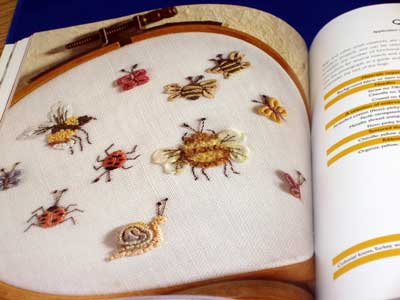
Then, the authors launch in to techniques, beginning with photo transfers, which I found interesting. The color photocopy of a picture, in mirror image, is applied to the fabric (using a solvent or lacquer thinner), heat set with an iron, then the embroidery is worked over it. I’ve never tried such a method, and I wonder about the chemical properties of lacquer thinners on fabric – it would be neat to explore this further!
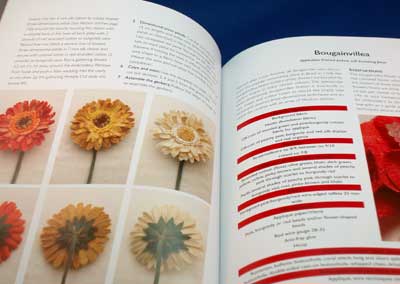
They continue the techniques section: preparation of background fabric, working with textured threads, scale and shading, applique, barbola, stumpwork inspired ideas, trapunto, felt, ribbon techniques, beading, networking, machine stitching, and working with metallic threads. A wide variety of techniques are used in combination on most of the projects!
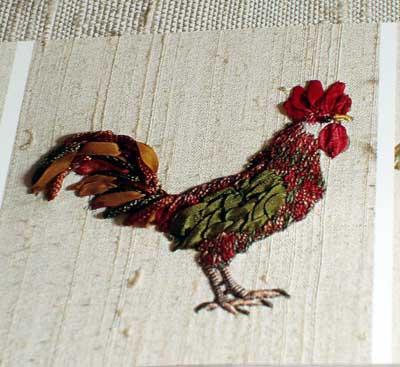
After taking the reader through the individual techniques, the book is divided into chapter headings by color inspirations: oyster white; red; green; yellow; blue; lilac & lavender; salmon; brown; pink; burgandy; indigo; and grey, black & white.
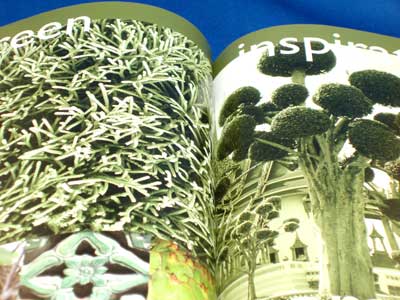
Under each of these chapter headings, you’ll find different projects that fit into the color categories.
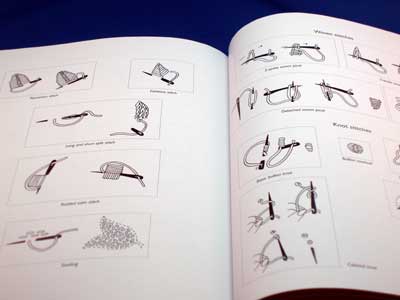
Finally, the book has a stitch glossary…
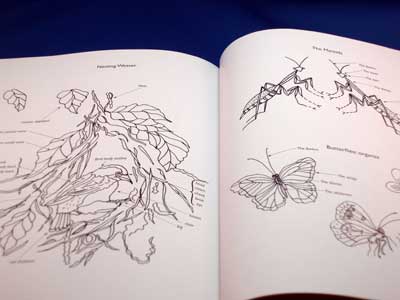
… followed by a section of templates for various projects.
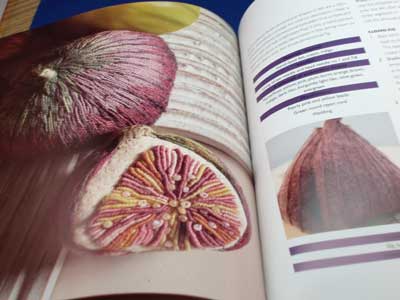
What delights me most about the book are the various projects featured in it. They are unbelievably beautiful and very realistic.
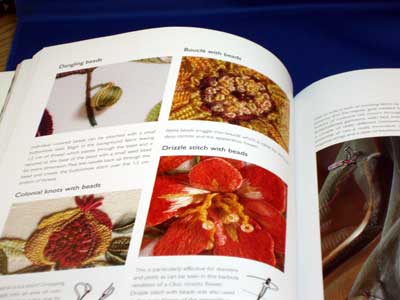
The pomegranates look as if the seeds are bursting out of the fruity flesh. The roosters look as if they could start crowing! The flowers beg to be picked, and most of the bugs – especially the grubby looking ones – make you shudder at their utter buggy creepy-crawliness.
The artistry of the authors is quite evident, as is the passion they have for their art. And truly, the book is about fiber art. It’s not strictly embroidery – many other techniques besides “stitching” fill these pages.
The pros of the book:
1. It’s a good resource for realistic inspiration. If you’ve ever wanted to recreate, with needlework, something that looks utterly real, then this book will help you do it.
2. It’s beautiful. It’s a coffee-table-conversation-starter book. Just point out some of the grubs crawing on some of the plants, and you’ll enchant your guests into discussing the wonders of needlework!
3. It instructs the reader clearly on techniques, and offers step-by-step guidelines for the various projects within. These guidelines are nice and clear.
4. There’s a really nice section full of line-drawn templates. The designs can be worked realistically, or if you’re more of a stylized sort of stitcher, they can still be adapted to stylized embroidery.
5. It’s fun. I enjoyed reading it and browsing through it.
Cons:
1. Some definite regional differences in the way threads are named are apparent in the book, and could cause confusion to the embroiderer. For example, in the US, Europe, and the UK, coton a broder is commonly known as a mercerized thread (it’s got a sheen to it) and flower thread is a matte thread (it doesn’t have a sheen to it). In the book, this is reversed, due to an apparent regional difference in terminology: flower thread is listed as a mercerized thread and coton a broder as a matte thread.
2. I don’t normally hard-line classify books as “beginner, intermediate, advanced,” because I’m convinced that beginners can pick up a book and learn what are classified as adv
anced techniques. But this is a book that I’d say is definitely intermediate and beyond. There are some things in it that a beginner could pick up – and still, any determined beginner can accomplish even the advanced techniques in it. However, I’d not recommend it to a newbie at embroidery.
3. For most of the projects, the fibers involved are not so easy to come by, and tend towards being very expensive, especially if you have to order them from overseas. If you don’t already do this kind of stuff, I could see the development of another whole stash! Still… it would be worth it, if you want the beautiful end product!
Overall, I like the book very much, and I’m glad I’ve added it to my library! I think intermediate to advanced stitchers will really like it, as it will certainly give you a new perspective and plenty of inspiration for your embroidery projects!







I saw your photo of the bugs – and I want the book!!!! (never mind the rest)
I bought this book recently and I’m really liking it. I think what I like best about it is the technique section because they explain some things that you don’t find in other books (like how to use textured threads). The projects are pretty awe inspiring too.
Everyday when I open my reader, yours is the first bog I check out.
Yesterday I stumbled upon this book as I was ordering a white work book (inspired by your sampler) from amazon. I couldn’t resist adding this one as well. I’m especially excited about the sort of patchwork looking project with all different leaves and bugs. Your great review makes me happy. If you liked it, I’m sure I will.
This is a great book. I have the earlier edition called Just Stitch.I hope you dont mind, but i’ve included a link to my flickr page because i have embrodiered some chickens, passionflower and fruit using this book as inspiration (the berries are hers too, but come from an Inspirations mag project. Although she uses lots of fancy threads i have managed with perle 8 cotton, stranded cotton, silk and organza ribbons, fabric scraps, seed beads and novelty knitting yarns from the $2 shop. You can see some of my adaptations here: http://www.flickr.com/photos/26630168@N03/sets/72157605147822959/
Thank you for the review, I’ve requested the book through Inter-Library Loan. I was particularly interested in the flowers, since I’ve been inspired to make brooches in embroidery (In large part inspired by you)
Thanks a lot for reviewing this book… I’ve also being eyeing it for a while … and like Elmsley Rose commented… The bugs picture did it for me as well !
Yesterday I got some coton a broder for the 1st time, the wrapping also called it flower thread… it is from DMC and here is a link of a picture a took in case you will like to check:
http://www.flickr.com/photos/mygoals_mismetas/3391099206/
Maybe in the book they called it like that because some brands do ? That just my guess.
Thanks Again, I really enjoyed this review !
Hi, All – glad you like the book review…
I did some searching about on that name. “Coton a broder” is a generic term, it seems (French…) for embroidery cotton, and within it, are different categories. On many DMC labels (DMC is a French company originally), the label will read “coton a broder” because it is cotton embroidery thread.
So, it’s really just a generic term, and can include all kinds of embroidery cotton, from flower thread to floche…
Thanks again, all….
MC
Can’t keep up with you, Mary, but I’m here today, just waving “hi.” A very enjoyable book review. I never visit your site without learning. Thanks for your blog.
I’m with JoWynn in keeping up with you! Anyway, I own this book and love it so I agree with your review – plus I feel the same way about the quirky title…without seeing the cover and examples from the inside, I wouldn’t have bought it strictly from the title…
I ordered this book last week, before seeing your review—now i can hardly wait for it to arrive!!! I’ve recently been adding more dimension in stitch and fabric manipulation to my “The Artist’s Body” series and plan on using some of my hand twisted fabric cording as well with these techniques!
I looooove this book! It’s the pictures that made me buy it – it’s so hard to buy a book unseen, but I’m glad I did….And to me, it not being a beginner book is not a con! There are so many books for beginners, it’s nice to see something for some of us who have done a few stitcheries!
~Lin Moon
i really want this book but i don’t know where to buy it. amazon only ship to Jakarta (indonesia) and i live at West Nusa Tenggara. this is very annoying!!!